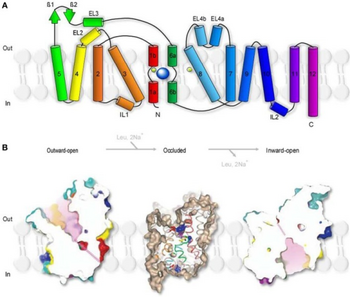GABA transporter
GABA transporters (
These transporters are primarily responsible for the regulation of extracellular GABA concentration during basal and synaptic activity. They are responsible for creating a GABA gradient which is determined by the
Types

The GABA transporter group consists of six different transporters:
- SLC6A1)
- GABA transporter type 2 (GAT2; SLC6A13)
- GABA transporter type 3 (GAT3; SLC6A11)
- SLC6A12)
- SLC6A8)
- SLC6A6)
GAT1 and GAT3 are the major GABA transporters in the brain and spinal cord, expressed by both neurons and some astrocytes.[4] GAT2 and BGT1 are also expressed in the brain, but at low levels and mostly in the meninges. GAT2 also transports taurine, while BGT1 transports betaine. These two transporters are predominantly expressed in the liver, but are also found in the kidneys and, as mentioned above, in the meninges.[4]
Function

GABA transporters in the plasma membrane help in regulating the concentration of GABA in the
Structure
The structure of Sl6 family transporters share 20-25% sequence similarity with LeuTA[6] providing an evolutionary relationship between the transporter and the leucine transporter protein.[2] Because of the similarity, the LeuTa protein provides a very close template model for the studying the transporters in greater detail.[1] The GABA transporter exists in two different conformations. The transporters have general structure of 12 alpha helices with both end - N Terminus and C-terminus in the cytoplasm with glycosylation sequence in the transmembrane helices.[7] They also exhibit ligand gated ion channel properties as well as substrate dependent properties of leak current. The amino acid sequence ranges from 599 (GAT1) to 700 for glycine transporters.[5]
Role in epilepsy

GABA creates an inhibitory tone in the
